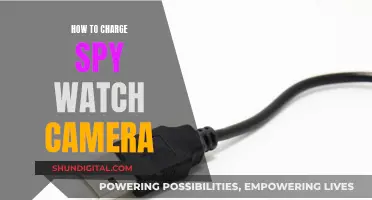
Travelling with camera equipment can be daunting, especially when it comes to keeping your batteries charged. Most camera batteries are lithium-ion, which are regarded as dangerous commodities due to their potential to short-circuit or catch fire. As a result, there are tight guidelines for their carriage on planes. However, with some planning, you can ensure your batteries are charged and ready for use during your international travels. Here are some tips to help you charge your camera batteries safely and effectively while abroad.
| Characteristics | Values |
|---|---|
| Voltage in the USA | 120V |
| Voltage in the UK | 230V |
| Voltage in Europe | 220V |
| Number of lithium batteries allowed on a flight | 2 large lithium batteries between 101 and 150Wh and an unlimited number of batteries under 100Wh |
| Where to store lithium batteries on a flight | Carry-on luggage |
| How to protect camera battery terminals on a flight | Tape the charging interfaces or connectors |
| How to adapt voltage when travelling to Europe | Use an adapter |
What You'll Learn

Check if your camera battery charger is universal
When checking if your camera battery charger is universal, it's important to understand what a universal camera battery charger is and how it works.
A universal camera battery charger is a type of charger that is compatible with various camera batteries of different sizes and brands. It has a broad voltage range and adaptable current that can connect to the battery and initiate charging. These chargers are designed with different shapes and features, and some even come with extra capabilities like USB ports for charging other devices simultaneously.
To check if your camera battery charger is universal, you should:
- Examine the Compatibility: Verify the compatibility of your charger by checking the manufacturer's specifications and compatibility list. Ensure that the charger's voltage and current parameters are suitable for your camera battery.
- Identify the Charging Connector: Locate the charging connector on your camera battery, which is usually marked with positive (+) and negative (-) signs to distinguish the ends.
- Check for Universal Features: Look for features like adjustable contacts, movable pins, or swappable mounting plates that allow the charger to accommodate different battery types.
- Review the Charger's Specifications: Check the charger's specifications, such as input and output voltages, adaptability, and any included adapters or plugs for international use.
- Consider Your Battery Type: Universal chargers typically support a wide range of battery types, including Li-ion, Li-Po, AA, and AAA batteries. Ensure that your battery type is compatible with the charger.
- Charging Slots and Efficiency: Note that universal chargers may have multiple charging slots, but their power delivery efficiency might be limited. They are typically designed to charge one battery at a time.
By checking these factors, you can determine if your camera battery charger is universal and suitable for your specific needs when travelling internationally.
Charging Your Kodak Camera Battery: How Long Does It Take?
You may want to see also

Understand the difference between adapters and converters
When travelling internationally, it is important to understand the difference between power adapters and converters. Adapters and converters are two different devices and serve different purposes.
Adapters allow your device to fit into the wall socket in the country you are visiting. Different countries have different plug shapes, so an adapter changes the plug configuration so your device can be plugged in.
Converters, on the other hand, change the electricity voltage going into your device. Countries have different voltages, for example, the US and Canada have 120V electricity, while European countries have 220V electricity. If your device is not dual voltage, you will need a converter to change the electricity voltage to ensure your device works safely.
Most modern devices such as phones and laptops are dual voltage, so you will only need an adapter. However, devices such as hair dryers and straighteners are not usually dual voltage, so you will need a converter for these.
Adapters are typically lighter and less bulky than converters, which tend to be large and heavy. It is worth checking if you need a converter before travelling, as you may be able to leave it at home and save space in your luggage.
In summary, adapters change the plug configuration, while converters change the electricity voltage. For international travel, you will likely need an adapter, and possibly a converter if your devices are not dual voltage.
Charging Camera Batteries: First-Time User Guide
You may want to see also

Tape up the metal contacts on your batteries
When travelling with camera equipment, it's important to keep your batteries safe and secure. Taping up the metal contacts on your batteries is a vital step in this process. Here are some detailed instructions on how to do this effectively:
Firstly, it is important to note that you should only use clear sticky tape to cover the metal contacts. This is because other types of tape, such as parcel tape, can leave marks or residue on your batteries. The tape should be wrapped around the battery in a way that completely covers all exposed metal parts. This includes both terminals of the battery, as these are the metal contacts that can cause sparks and catch fire if they touch. Make sure that the tape is secure and won't easily come loose.
It is also worth noting that different types of batteries have terminals in different places. For example, AA batteries have terminals at both ends, while 9-volt batteries have two terminals at the same end. Button battery terminals are on the base and should be covered in clear tape on all sides.
Additionally, you should always dispose of your batteries responsibly. Used batteries should be stored in a glass container that is not airtight, as pressure can build up. Do not store them in a metal container or with metal objects, as they can spark and create a fire hazard. Keep them in a cool, dry place, away from heat sources, and make sure they are out of reach of children, especially small button batteries that can be easily swallowed. When you are ready to dispose of them, take them to a battery recycling drop-off point in a fire-resistant container, such as a glass jar.
Taping up the metal contacts on your batteries is a simple but crucial step in battery safety when travelling with camera equipment. It only takes a few minutes and can help prevent fires and other hazards.
Samy's Camera and Texas Sales Tax: What's the Deal?
You may want to see also

Keep your camera batteries in your carry-on luggage
Keeping your camera batteries in your carry-on luggage is a good idea for several reasons. Firstly, it ensures that your batteries are easily accessible and within reach during your flight. This is especially important if you need to charge your camera batteries during the flight or if you need to use your camera immediately upon arrival at your destination.
Secondly, carrying your camera batteries in your hand luggage provides peace of mind regarding their safety. Camera batteries, especially lithium-ion batteries, are considered dangerous goods due to their potential to short-circuit or catch fire. By keeping them in your carry-on luggage, you can monitor and protect them from damage or temperature and pressure changes that may occur in the cargo hold.
Additionally, international laws for air travel prohibit placing lithium batteries in checked baggage. These laws include camera batteries, which are typically lithium-based. By carrying them in your hand luggage, you are complying with these regulations. Remember to check the latest regulations before your flight, as laws and policies regarding battery transportation can change.
To safely pack your camera batteries, consider the following:
- Use a hard case, such as the Pelican 1510, that meets carry-on size requirements and can accommodate your camera and batteries.
- Tape the metal contacts on your batteries to prevent short-circuiting. Use camera tape to avoid leaving sticky residue.
- Keep your batteries in their original packaging or a protective case to avoid damage and for easy identification during customs checks.
- Mark your batteries clearly to facilitate customs checking, especially when travelling with multiple batteries.
- Protect the battery terminals by taping over the charging interfaces or using the manufacturer's packaging to prevent short circuits.
- Store the batteries in separate bags to enhance safety and avoid accidental activation.
Charging for Cameras: How to Price Your Photography Equipment
You may want to see also

Pack your camera in a hard case
When packing your camera gear for international travel, it's essential to invest in a high-quality hard case to protect your equipment. Here are some detailed instructions and tips for packing your camera in a hard case:
Choose the Right Hard Case
Select a hard case that is specifically designed for cameras and offers maximum protection. Look for features such as a sturdy exterior, soft foam inserts, and a watertight seal. The case should also be dustproof and shockproof to safeguard your camera from impacts, moisture, and harsh environments. Ensure the case has a secure locking mechanism to prevent theft.
Consider the Size and Weight:
Hard cases come in various sizes, so choose one that comfortably fits your camera model and any additional accessories you plan to carry. Keep in mind the weight restrictions for carry-on luggage when selecting your hard case. The Pelican 1510, for instance, is a popular option that complies with carry-on size restrictions.
Organise Your Gear:
Arrange your camera equipment neatly inside the hard case, utilising any dividers or compartments available. This will help keep your gear organised and prevent it from shifting during transport. Place essential items, such as extra batteries, in easily accessible compartments.
Protect Your Lenses:
If you're travelling with multiple camera lenses, ensure each lens has its own protective case or wrap it in a soft cloth before placing it in the hard case. This will prevent scratches and reduce the risk of impact damage during travel.
Include Accessories:
Don't forget to pack essential camera accessories, such as charging cables, extra memory cards, and card readers. Keep them organised within the hard case using small pouches or mesh bags. This will ensure you have everything you need for your international trip.
Secure the Hard Case:
Once you've packed your camera and accessories, ensure the hard case is securely locked or sealed. Use heavy-duty cable ties instead of padlocks to make it more challenging for thieves to access your equipment. If you're concerned about airport security cutting the ties, include a few spares inside the case so they can reseal it after inspection.
Charging Your ADT Camera Battery: A Step-by-Step Guide
You may want to see also
Frequently asked questions
Most camera battery chargers are universal, meaning they can take a wide variety of inputs and make it work. However, if your charger is not universal, you will need to purchase a converter, which will convert the current from what’s coming out of the wall to the specific voltage and hertz your charger needs. You will also need an adapter to make the physical plug of your charger work with the different power outlets in other countries.
You can carry lithium-ion camera batteries of up to 100Wh in your carry-on luggage. Each passenger can carry two spare lithium-ion camera batteries. Make sure to tape over the charging interface or connectors to avoid short circuits.
It is recommended to carry your camera batteries in your carry-on luggage. Store them in their original packaging or a protective case to avoid damage and for easy identification during customs checks.







